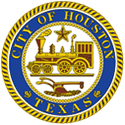 > Planning > Department History
> Planning > Department History Planning and Development Department - Our History
Timeline of Key Houston Planning Dates, 1913 - Present
1913, March 1: A Boston landscape consultant named Arthur Comey produced the first comprehensive development plan for Houston. Entitled "Houston: Tentative Plans for its Development," the plan was presented to the Houston Parks Commission because there was no Planning Department or Planning Commission at the time.
1921: Mayor Oscar Holcombe appoints Lindsay Blayney, a professor of German at Rice Institute, as chairman of a 100-member citizens committee to establish a city planning commission that would be “removed from politics” and could “carry out a great system of city building.” City Engineer J.C. McVea reports that Houston suffers from three critical planning problems: no major street plan, no zoning ordinance, and limited power to review subdivision platting.
1922, October: Planning Commission first established by Mayor Holcombe with only 4 members. The Commission was created as a purely advisory body without formal authority.
1927, June 29: Planning Commission re-established after going inactive and a rudimentary Planning Department was created to work on its behalf. William C. Hogg is chair of commission.
1928: The Planning Commission approves the “Rules for Land Subdivision,” the first formal rules for development in Houston. The rules encouraged developers to submit preliminary and final plats and to comply with standards for block length, street width, and minimum lot size. However, the rules were purely voluntary.
1929, October 30: One day after the “Black Tuesday” stock market crash, Hare & Hare planning consultants publish a report on behalf of the Houston Planning Commission and the Houston Parks Commission with recommendations for appropriate city planning in Houston. The plan included the first proposed zoning ordinance for Houston. However, the zoning ordinance failed after heated opposition from the Houston Property Owners League and the Planning Commission was disbanded shortly afterward.
1937: The Planning Commission was reconstituted to once again investigate the possibility of creating a zoning ordinance because the deed restrictions in the Montrose area had just expired. However, intense political opposition caused the City Council to withdraw funding for the Commission and consequently the second effort to enact zoning was abandoned.
1940, February 14: On a cold Valentine’s Day, the Department of City Planning was created by city ordinance and the Planning Commission was re-formed. This time, both would endure.
1942: The Planning Department produced Houston’s first “Major Street Plan,” now known as the “Major Thoroughfare and Freeway Plan” and revised annually.
1948, November 2: Zoning fails for third time at citywide straw poll
1962, November 6: Zoning fails for fourth time at citywide straw poll
1963: Texas Legislature grants cities rights over their ETJ (Extra-territorial Jurisdiction), paving the way for Houston’s geographic expansion.
1965, August 19: City Council passes ordinance authorizing the City Legal Department to enforce Deed Restrictions in court (65-1967)
1976, June 2: Land Platting Policy Manual approved by Planning Commission as a more organized successor to the Rules for Land Subdivision. However, following the rules was still voluntary for developers, though incentives were given to encourage compliance.
1982, June 22: Chapter 42 created by city ordinance to govern development. Houston has mandatory development rules for the first time.
1984, February 28: Department of City Planning is renamed “Department of Planning & Development”.
1989, May 17: Off-Street parking ordinance passed
1991, December 4: Tree and Shrub ordinance passed.
1991, December 11: Cell Tower ordinance passed regulating the location of cell towers.
1992, June 10: Hotel/Motel ordinance passed regulating the location of hotels in residential areas.
1993, November 2: Zoning fails for fifth time at citywide referendum.
1995, March 1: Historic Preservation ordinance passed. Historic Tax Exemption ordinance also passed to accompany preservation ordinance.
1996, December 18: Hazardous Enterprises ordinance passed, largely in response to the 1995 chemical fires in a Pleasantville warehouse.
1998, April 8: Houston Tower Commission formed to evaluate proposed towers that have been protested or that require waivers to meet the requirements of the ordinance.
1999, March 24: Chapter 42 comprehensively amended for first time. Distinction made between “urban” and “suburban” Houston (inside/outside the 610-loop). The “Special Building Line Requirement area” tool for neighborhood protection (called “prevailing building line” at the time) was included as part of the Chapter 42 rewrite.
2001: One of Houston’s worst years. Tropical Storm Allison ravages Houston in June, causing $5 billion in damage to Harris County; and Enron collapses in October.
2004, January 1: METRORail’s Main Street light rail line opens in time for Super Bowl XXXVIII at Reliant Stadium.
2007, October 10: Parks and Open Spaces amendment to Chapter 42 passed, requiring builders to dedicate land or pay a fee in-lieu-of land dedication in proportion to the size of their development.
2009, January 28: Prohibited Yard Parking ordinance passed, prohibiting homeowners from parking vehicles on unimproved surfaces in their front or side yards.
2009, August 19: Transit-Corridor amendment to Chapter 42 passed, incentivizing pedestrian-friendly development along METRO’s light rail corridors.
2010, October 13: Amendments to the Historic Preservation Ordinance, Chapter 33, passed creating permanent protections for historic properties in historic districts.
2010, December 21: amendments to Chapter 42 passed creating a section known as the Residential Buffering Ordinance to provide buffering requirements when a development is proposed that is over 75 feet in height and is located along a local or collector street and abuts single family residential.
